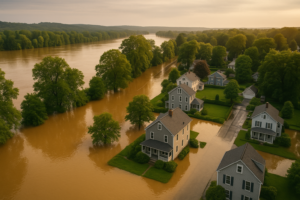Dense orange smoke drifting over Cape May isn’t the postcard most Jersey Shore rental owners expect in May, yet there it was last month as the Jones Road Fire raced through 5,000 acres of the Pine Barrens and forced brief evacuations of more than 1,300 homes. AP News Simultaneously, 350 miles to the northeast, the Maine Forest Service was sounding its own alarm: “High” wildfire danger statewide after a string of single-digit humidity days and a stubborn rain deficit. WMTW
Wildfire is no longer a purely Western headline. From the scrub oak of southern New Jersey to the spruce ridges of Down East, fires are finding more fuel—and more suburban porches—in places long considered safe. The latest North American Seasonal Fire Outlook shows a ribbon of “above-normal potential” arcing across parts of the Northeast into July. National Interagency Fire Center
“We’ve Never Evacuated for Fire Before”
Pine Barrens residents who fled April’s blaze told reporters the flames moved faster than traffic on the Garden State Parkway, embers leaping wetlands they assumed would act as fire breaks. Dry winters leave pine needles crisp by spring; add a gusty sea-breeze and a small brush burn becomes a crown fire in minutes.
Insurance adjusters who later walked those neighborhoods found a patchwork of outcomes: some houses unscathed, others with melted vinyl siding and attics full of smoke residue. Homeowners learned that smoke infiltration can cost nearly as much to remediate as direct flame damage—and that carriers scrutinize evidence when losses are measured in odor rather than char.
Northern Forests, Southern Rules
Maine’s fire-danger boards rarely climbed this high so early in the year, yet volunteer crews near Newfield spent hours chasing a 10-acre brush fire that ignited along Swan Pond in mid-May. WMTW The incident was minor by Western standards, but the manpower—and insurance payout risk—was anything but. Most New England homeowner policies cover wildfire, but the fine print on debris removal, code upgrades, and ALE (Additional Living Expenses) can shrink reimbursements once the smoke clears.
Three Quiet Lessons from a Busy Spring
-
Defensible space is cheaper than ash cleanup. Clearing flammable brush within 30 feet of the house isn’t just a West Coast tip; it’s emerging as an underwriting requirement in parts of New Jersey and Connecticut.
-
Photographic proof beats memory every time. Post-fire disputes often hinge on pre-loss condition. A five-minute smartphone walkthrough of the attic and mechanical room pays dividends if smoke forces a replacement furnace claim.
-
Know your sub-limits. Standard policies sometimes cap tree removal and landscaping at 5–10 percent of Coverage A. In heavily wooded neighborhoods, that cap is reached before the first stump grinder rolls up.
What to Watch as Summer Advances
State forestry agencies warn that early-season dryness can lead to double-peaked fire years—one spike in spring, another in late summer when vegetation cured by June heat becomes tinder. Meanwhile, insurers eye loss data: New Jersey logged 1,400 wildfires and 11,000 burned acres in 2024, prompting some national carriers to prune coastal ZIP codes. Bloustein School If 2025 trends higher, more non-renewal letters could follow.
For homeowners, the playbook is mundane but essential: keep receipts for any fire-mitigation work, update that contents inventory you tweaked after Sandy, and store a copy off-site. Should a blaze reach the tree line, the paper trail you build now—photographs, serial numbers, permits—will shape the conversation with whichever adjuster eventually arrives, public or otherwise.
Wildfire may still feel like a stranger in the Eastern woodlands, but it’s already ringing the doorbell. Preparation, not panic, will decide whether it remains a brief visitor or an expensive long-term guest.




